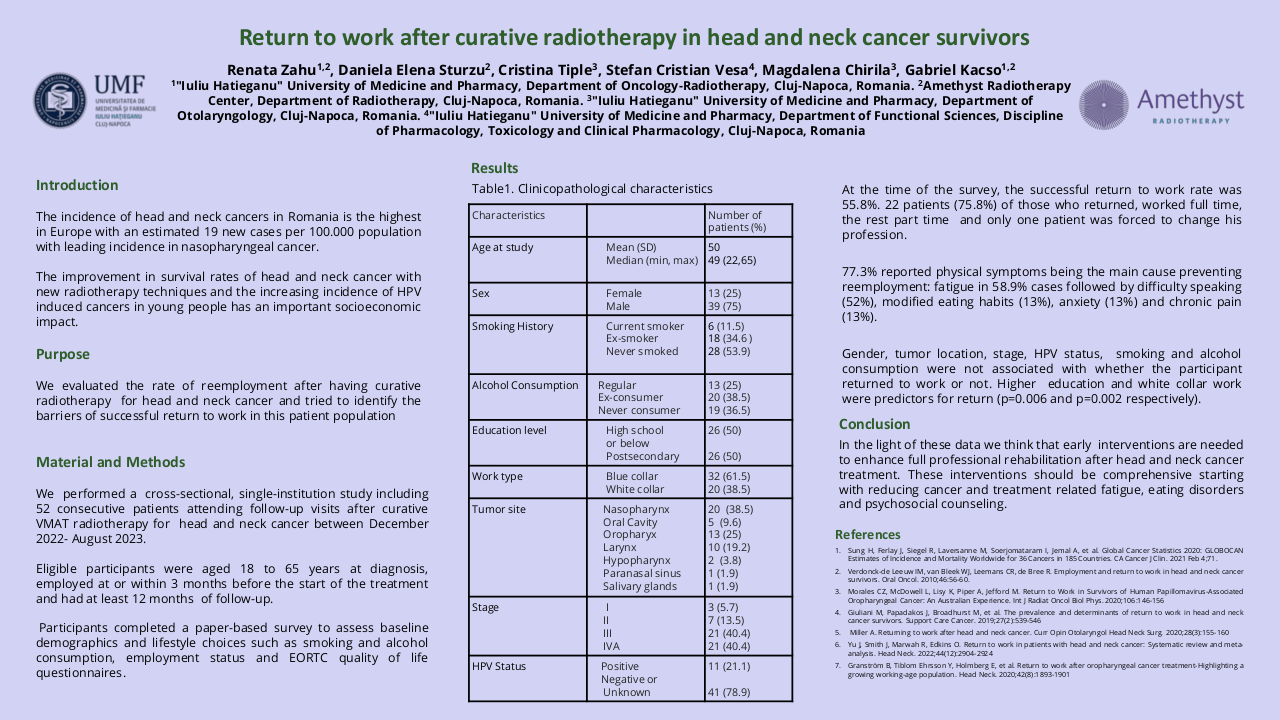Return to work after curative radiotherapy in head and neck cancer survivors
Purpose/Objective
The improvement in survival rates of head and neck cancer patients and the increasing incidence of HPV induced cancers in young people has an important socioeconomic impact. We evaluated the rate of reemployment after having curative radiotherapy for head and neck cancer and tried to identify the barriers of successful return to work in this patient population.
Material/Methods
We performed a cross-sectional, single-institution study including 52 consecutive patients attending followup visits after curative VMAT radiotherapy for head and neck cancer between december 2022- august 2023. Eligible participants were aged 18 to 65 years at diagnosis, employed at or within 3 months before the start of the treatment and had at least 12 months of followup. Participants completed a paper-based survey to assess baseline demographics and lifestyle choices such as smoking and alcohol consumption, employment status.
Results
Mean age was 50 (22-65 years) and 75% were male. Most participants (38.5%) had nasopharynx cancer followed by oropharyngeal cancer in 25%. Successful return to work rate was 55.8%. Only 8 patients (15.4%) returned earlier than 6 months to employment. 22 patients (75.8%) of those who returned, worked full time and one patient was forced to change his profession.
At the time of the analysis 23 cancer survivors (44.2%) were not working. 18 of these choose early retirement and are not planning to return, the rest of 5 patients are still on sick leave and might plan to reemploy. 77.3% reported physical symptoms being the main cause preventing reemployment. The most common physical symptom reported was fatigue in 58.9% cases.
Conclusion
With all technical improvements in treatment delivery with the scope of reducing long term toxicity there is still an important percentage of head and neck cancer survivors not able to return to work after radiotherapy. Professional assistance in their cancer rehabilitation is needed to increase reemployment rates. The high incidence of fatigue in this population warrants further research.
1.Kjær T, Bøje CR, Olsen MH, et al. Affiliation to the work market after curative treatment of head-and-neck cancer: a population-based study from the DAHANCA database. Acta Oncol. 2013;52(2):430-439 2.Baxi SS, Salz T, Xiao H, et al. Employment and return to work following chemoradiation in patient with HPV-related oropharyngeal cancer. Cancers Head Neck. 2016;1:4. 3.Verdonck-de Leeuw IM, van Bleek WJ, Leemans CR, de Bree R. Employment and return to work in head and neck cancer survivors. Oral Oncol. 2010;46:56-60. 4.Morales CZ, McDowell L, Lisy K, Piper A, Jefford M. Return to Work in Survivors of Human Papillomavirus-Associated Oropharyngeal Cancer: An Australian Experience. Int J Radiat Oncol Biol Phys. 2020;106:146-156 5.Giuliani M, Papadakos J, Broadhurst M, et al. The prevalence and determinants of return to work in head and neck cancer survivors. Support Care Cancer. 2019;27(2):539-546 6. Miller A. Returning to work after head and neck cancer. Curr Opin Otolaryngol Head Neck Surg. 2020;28(3):155-160 7.Yu J, Smith J, Marwah R, Edkins O. Return to work in patients with head and neck cancer: Systematic review and meta-analysis. Head Neck. 2022;44(12):2904-2924 8.Granström B, Tiblom Ehrsson Y, Holmberg E, et al. Return to work after oropharyngeal cancer treatment-Highlighting a growing working-age population. Head Neck. 2020;42(8):1893-1901





